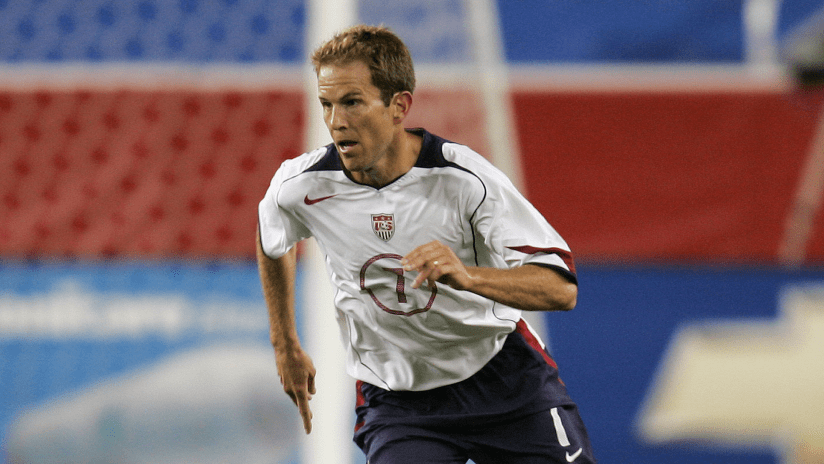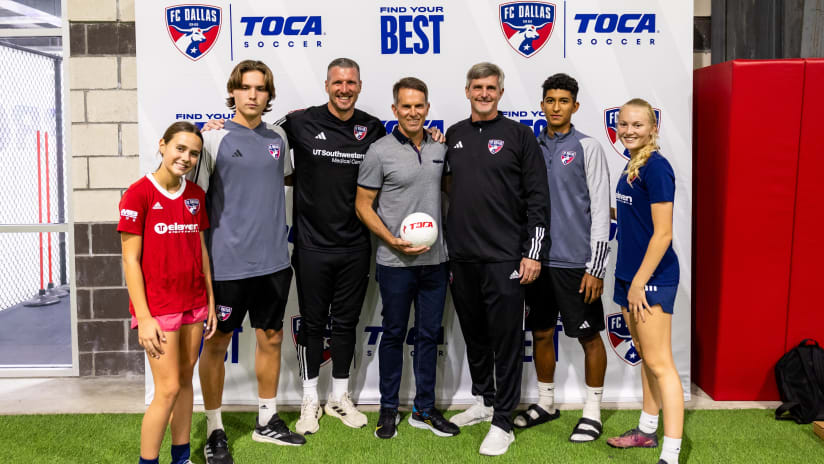Eddie Lewis had options when he called time on his distinguished playing career at the end of the LA Galaxy’s 2010 season.
An MLS original whose former coach Bruce Arena once dubbed “arguably the finest left-sided midfielder in the history of U.S. Soccer,” Lewis had built ample respect – and contacts – on both sides of the Atlantic after starring for the Galaxy, San Jose, Fulham FC and three other prominent English clubs for 15 years, earning 82 US men’s national team caps and two World Cup adventures along the way.
“When I retired, I could’ve taken the sporting director role at the Galaxy, or an assistant role for Jason Kreis at Salt Lake,” Lewis told MLSsoccer.com in a one-on-one conversation at Soccerex in Miami earlier this month. “And I had this idea of starting TOCA, which, for a couple of years, I was worried was going to be a really bad decision. I was putting a lot of my own money into this concept and had passed up some good opportunities.
“But this is really where my passion lies.”
What is TOCA Football?
That would be TOCA Football, the technical-training company he launched instead of taking one of those technical-staff jobs. Lewis had experienced his own ‘aha moment’ years before as a college student at UCLA, where he saw the basketball team shooting on smaller-than-regulation rims to hone their accuracy. He applied that idea to his sport by practicing receiving and ball-striking with tennis balls, first manually and later with a tennis-ball machine firing them at him, logging hundreds of touches per session.
He saw such a rapid improvement in his fundamentals that it inspired him to throw himself into the concept of a specialized, patented version after he retired. Machines called TOCA Touch Trainers deliver smaller, lighter TOCA balls – similar to a size 3 ball, allowing players to log a high volume of repetition without the muscle fatigue imposed by a conventional size 4 or 5 – at a range of speeds and angles that can be customized by an accompanying app on a tablet or other smart device.
The next iteration was ‘Smart Targets,’ small goals with LED lights that direct a player’s next movement, be it passing or shooting, at a variety of programmable heights and spots. The system’s range of uses quickly multiplied well beyond youth technical training, with a growing list of college and professional players like Christen Press, Alex Morgan, Mallory Swanson and Gyasi Zardes using it for offseason workouts, sharpening awareness and decision-making and the latter stages of injury rehabilitation.
As the business blossomed, Lewis and his partners gleaned other lessons.
“We started really as just technology sort of inside another existing soccer center,” he said. “We quickly realized, we can probably operate these things better than some of the existing owners. So at that point, we really began to open our own centers. That quickly became very successful and we began an acquisition strategy after that, to go around and look for opportunities to get into other centers in which we could really own and operate the experience end to end.”

Soccer’s decades of growth in North America had fueled the propagation of indoor facilities, places where small-sided leagues and individual or small-group training like the TOCA system could happen year-round regardless of weather. But the space seemed ripe for modernization, especially considering the substantial overhead and periods of the day and week when traffic dipped.
“What I've noticed is soccer centers that were once originally hockey centers, and they suddenly just put turf down and you have this walled seven- or eight-a-side field,” explained Lewis. “They look very similar to how they did back in the early ‘80s and in many respects were operating the same way they were then too. I just think the soccer fan, the soccer player has evolved quite a bit since then.”
Today TOCA operates 39 (and counting) indoor centers across North America from Vancouver to Nashville, with thousands of regular users, including kids as young as 18 months getting introduced to the game via the ‘TOCA Soccer Classes’ early-childhood program. Yoshi Maruyama, a former senior executive at DreamWorks Animation and Universal Parks & Resorts, climbed aboard as CEO four years ago. Clubs and associations, both domestic and abroad, began to sign up to use the training system, and last autumn MLS signed a 10-year partnership with TOCA that includes a shareholder stake for the league.
Families can get a free sample of all that at TOCA locations in Denver, Atlanta, Naperville, Nashville and Madison on Dec. 2, as MLS x TOCA Kickoff Parties take place at five of the company’s centers, with more such events, as well as watch parties and the like, slated for the coming months.
Next-level technology
Development-centered clubs like FC Dallas are already adding the TOCA technology, which Lewis calls “our core product and proprietary differentiator,” to their youth curriculums. But the vision runs broader still. The parent of three children, the youngest of whom currently competes in MLS NEXT with Ventura County Fusion, Lewis saw chances to better connect with the adults who were bringing in their kids for TOCA sessions as the company’s network of facilities grew.
That gave birth to TOCA Social, a more all-encompassing offering billed as “the world's first and only immersive football and dining experience” when its first location opened in a 30,000-square-foot space at The O2 in London in 2021.
“People call it the Topgolf for soccer,” said Lewis. “We leveraged a lot of the same technology that we use on the sports side of the business, and created this really incredible immersive and interactive experience with a huge screen. Guests can kick volleys and kill zombies or hit targets while having a drink with some friends and just in casual clothes. So that's been a lot of fun and a really unique opportunity for us, and one that scales globally.
“Whether it's bringing in five-a-side pitches vs. a big seven-a-side pitch, really investing in the F&B [food and beverage] side of the experience so that we can extend that relationship from just coming in to play a league game to hanging out and having a beer after the game, to really sort of continue that connection with our guests, as well as the camaraderie with the fans … We're really looking to just level up that whole indoor soccer experience. So far, it's been working pretty well.”
More TOCA Social venues are slated to open soon, including Birmingham, England, a second London venue, and several sites across Mexico, with the first site in Monterey, Mexico. English star Harry Kane has signed on as an investor, along with nine-figure levels of venture-capital funding fueling plans for marked expansion in the coming months and years, with a particular focus on the watershed event coming in 2026.
“I think like most companies here in the US, we're really looking to try and take advantage of the run-up to the World Cup. And that's coming very, very quickly,” said Lewis. “So we're in the middle of a big capital raise at the moment. Proceeds are earmarked towards scaling very quickly here in the US, particularly MLS and World Cup markets.
“This generation of parents grew up playing the game, themselves, and are now active soccer fans. They are bringing their kids to games – not just because their kids play or because their kids want to go to the games, but because as a parent, they want to share that relationship to the sport with their kids.”

US Soccer evolution
Lewis has made an impressive transition from the pitch to the boardroom, though he keeps a close watch on his old teams, and not just for business reasons.
“The US team in particular, it's a really interesting time,” he said. “I think, especially at the last World Cup, there was always this built-in sort of, not excuse, but this idea that, ‘hey, this is a very young team, and in many ways, it's almost being built for 2026.’ I think to a certain extent that's true. With that group, at a very young age, there was a lot of real promise.
“Each of those players have to continue to try and not just be a part of big clubs, but continue to play and play week in, week out with these clubs. While they're far better than, certainly, we were in the day, the world's a lot better, too.”
Some lively arguments recently erupted on social media around the question of whether the current vintage of the USMNT would defeat the 2014 edition, or the 2002 side he helped reach the quarterfinals in Korea/Japan. Lewis laughs at that idea.
“Oh, it's not a debate,” he said. “These guys are fantastic footballers. I mean, the game has evolved, but these guys are great. They lack maybe a little bit of experience with their age, but they're incredible players. The bigger challenge, in my opinion, is the fact that there's just more good countries today than there were back then. There were your usual suspects back in the day, and today almost any country can put 15 really good players out there.”
The nature of that moving target constitutes a real challenge for the next phase of progress for North American soccer. While he’s realistic about the work left to be done to push the USMNT into the global elite, Lewis hopes his company can play some role and is proud to still be part of that pioneering mission.
“For me, the most important thing is finding a way to give back,” he said. “Any player from my generation, regardless of how much or how little money they were able to make from the game, they will always be a part of the generation that was about building the foundation for future generations. And I think, as long as players continue to do that, and do that in the right way, then as far as I'm concerned, they’re doing the country a service.”










